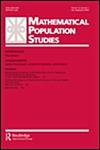出生死亡率的熵估计
IF 1.3
3区 社会学
Q3 DEMOGRAPHY
引用次数: 0
摘要
摘要在有限的状态空间中,通过出生-死亡过程对种群进行建模。它的平稳分布是由它的出生-死亡比率来索引的。按总体大小获取的值的样本具有弹性样本平均值(观测值的平均值)、附加样本平均值、同步样本平均值。当最后两个均值为零时,那么,根据定义,信息在总体规模上是线性的。只有当人口规模呈几何分布时才会出现这种情况。将分布的熵与在任何样本上计算的熵相等涉及三个样本均值,并允许估计出生死亡率。只有在信息总体大小呈线性的情况下,该过程才简化为最大似然估计,只涉及弹性样本均值。该过程是在人口规模不再是线性的信息上演示的,例如人口规模的二项式分布,其中最后两个均值不是零,而是相等的,以及Pascal分布和Poisson分布,其中后两个均值既不为零也不相等。本文章由计算机程序翻译,如有差异,请以英文原文为准。
Entropy-based estimation of the birth-death ratio
ABSTRACT A population is modeled by a birth-death process in a finite state space. Its stationary distribution is indexed by its birth-death ratio. A sample of values taken by the population size has an elastic sample mean (mean of the observations), an additional sample mean (mean of the logarithms of the observations transformed by a given function), and a synchronizing sample mean (combination of the previous means). When the last two means are zero, then, by definition, information is linear in population size. This is only the case when the population size is geometrically distributed. Equalizing the entropy of a distribution to the entropy calculated on any sample involves the three sample means and allows for estimating the birth-death ratio. Only in the case of information linear in population size, this procedure reduces to maximum likelihood estimation, which involves only the elastic sample mean. The procedure is demonstrated on information that is no longer linear in population size, such as a binomial distribution of population size, where the last two means are not zero, but just equal, and a Pascal distribution and a Poisson distribution, where the last two means are neither zero nor equal.
求助全文
通过发布文献求助,成功后即可免费获取论文全文。
去求助
来源期刊

Mathematical Population Studies
数学-数学跨学科应用
CiteScore
3.20
自引率
11.10%
发文量
7
审稿时长
>12 weeks
期刊介绍:
Mathematical Population Studies publishes carefully selected research papers in the mathematical and statistical study of populations. The journal is strongly interdisciplinary and invites contributions by mathematicians, demographers, (bio)statisticians, sociologists, economists, biologists, epidemiologists, actuaries, geographers, and others who are interested in the mathematical formulation of population-related questions.
The scope covers both theoretical and empirical work. Manuscripts should be sent to Manuscript central for review. The editor-in-chief has final say on the suitability for publication.
 求助内容:
求助内容: 应助结果提醒方式:
应助结果提醒方式:


